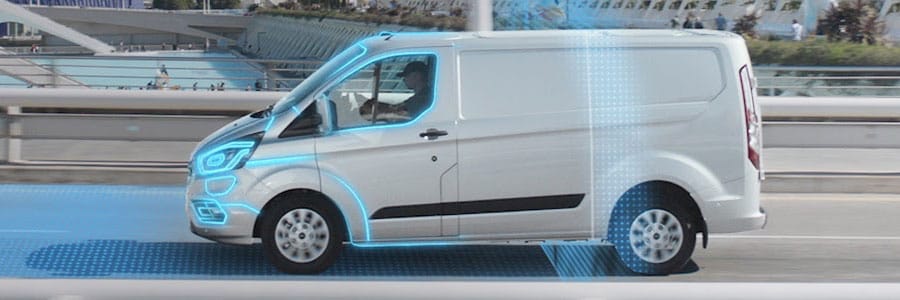Geofencing technology turns your vehicle green

Geofencing technology has been available with fleet telematics for many years, but now it's becoming central to both cars and vans as a standard fitment.
That's important for businesses operating in Clean Air Zones (CAZs) - or those that will be operating in CAZs once they have been implemented. Because geofencing can ensure your plug-in electric vehicle (PHEV) is running in emission-free battery mode when it enters a CAZ.
If you have not come across the term geofencing before, it refers to the creation of a virtual fence or boundary around a geographical area.
In practice this means that a vehicle can switch to battery power when it enters a CAZ or any other predefined area (such as near schools, or in the goods yard) to ensure it is zero emission.
To date, Ford and BMW are leading the way in making this technology available as a standard feature. Geofencing of London and Birmingham is automatic and as further cities become CAZs they will also be added to the database via Over-the-Air (OTA) updates.
Geofencing is available on the Ford Transit Custom PHEV and Tourneo Custom PHEV. It is standard fitment from this autumn and all customers that have leased or finance leased a Transit Custom or Tourneo PHEV prior to then are eligible to have geofencing retrofitted at no cost.
Meanwhile BMW is the first car manufacturer to use GPS geofencing technology. This will be introduced across its range of plug-in hybrid models operating BMW OS7 software.
BMW calls its geofencing technology ‘eDrive Zones'. To date it is standard on key business models such as the BMW 330e, BMW 530e, BMW 745e and BMW X5 xDrive45e, with additional compatible models launching in the future. BMW eDrive Zones is also available via a free over-the-air software update for compatible BMW plug-in hybrid vehicles, meaning existing customers can also benefit from this technology.
Both systems are ‘smart' and prioritise battery charge to ensure zero emission driving is possible within the geofence. For example, as the Ford approaches a geofence, the module takes action to ensure a minimum 60% state of charge. The dashboard display lights up with a green ring around the vehicle as it approaches a geofence; when it enters the geofence the green ring fills in to visually display its green running.
The geofence module in the Transit PHEV also records information about electric-only operation within geofenced areas. The encrypted data can be shared with authorities to confirm compliance with low-emission zone regulations, avoiding the risk of wrongful fines and penalties.
The BMW system performs a similar function via destinations entered in its satellite navigation system. It will conserve battery power during the journey to ensure that once the car enters an eDrive Zone it has sufficient battery power to run in electric-only mode.
Other manufacturers - such as Mercedes and Nissan - can create geofences via supporting apps, but both require the driver to switch over to battery operation manually, unlike the automatic versions from Ford and BMW.
The case for PHEVs and cleaner air
A recent study by Ford concluded that hybrid-electric vehicles could help improve urban air quality : 75% of miles driven in central London by study participants – which included operators Addison Lee Group, British Gas, Heathrow Airport, the Metropolitan Police and Transport for London – were completed in zero-emission electric-only mode.
BMW has done similar trials to establish how effective electric only driving is in city centres, and how it can assist improving local air quality. A study conducted in Rotterdam in the Netherlands, found that 90% of all routes within the trial zone were driven in electric-only mode.
Rob Marshall, operations director of Gateway2Lease, says both the Ford and BMW PHEV geofencing systems demonstrate how it can offer businesses the best of both worlds: electric-only driving in the city, where it makes the most difference, and a highly efficient internal combustion engine to cover long distances.
“For customers looking to make the transition to electromobility, plug-in hybrids offer a great deal of flexibility along with many tax advantages,” says Rob.
“Such vehicles can help improve the air quality of cities while reducing running costs for the business, and lowering exposure to benefit-in-kind taxation for the driver. It's wins all round.”
Company car taxation on plug-in hybrids is based on a combination of CO2 emissions and the number of miles that can be driven in zero emission mode. For example, a plug-in hybrid with CO2 emissions of less than 50g/km and that can travel between 30-39 electric miles, are taxed at 10% of the P11D value; if they can travel fewer than 30 miles, the benefit-in-kind rises to 12%. In other words, the more miles that can be travelled on the battery, the greater the tax saving.
Rob adds: “We would be happy to talk to companies and business owners about how plug-in hybrids can be added to their fleet, and advise on which models would be most appropriate.”
View our latest blog posts

Categories
Pages
We are a family run business based in rural Worcestershire. Our team of 38 staff are on hand to provide an exceptional service to personal and business customers.
Read More
